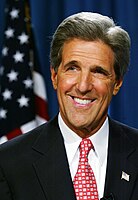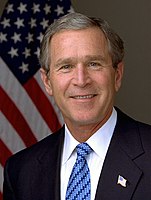
Back Elecciones presidenciales de Estados Unidos en California de 2004 Spanish Élection présidentielle américaine de 2004 en Californie French Wybory prezydenckie w Stanach Zjednoczonych w Kalifornii w 2004 roku Polish
| ||||||||||||||||||||||||||
| Turnout | 76.04% (of registered voters) 57.03% (of eligible voters) | |||||||||||||||||||||||||
|---|---|---|---|---|---|---|---|---|---|---|---|---|---|---|---|---|---|---|---|---|---|---|---|---|---|---|
| ||||||||||||||||||||||||||
 County results
| ||||||||||||||||||||||||||
| ||||||||||||||||||||||||||
| Elections in California |
|---|
 |
The 2004 United States presidential election in California took place on November 2 as part of the 2004 United States presidential election. Voters chose 55 representatives, or electors to the Electoral College, who voted for president and vice president.
California was won by Democratic nominee John Kerry by a 9.94% margin of victory. Prior to the election, all leading news organizations considered this a state Kerry would win, or otherwise considered as a safe blue state. Republican presidential candidates have not taken California's electoral votes since Bush's father George H. W. Bush in his victory over Michael Dukakis in 1988. Bush would become the first Republican to win two terms in the White House without winning California at least once. With its 55 electoral votes, California was John Kerry's biggest electoral prize in 2004.
This marked the first election since 1880 in which the Republican nominee won the nationwide popular vote without California and the first time since 1976 that it voted for the popular vote loser. It was also the first time since Californian statehood in 1850 that a presidential candidate, of any party, was elected to two terms to the presidency without winning the state either time.
2004 is the most recent election in which a Republican presidential candidate has received more than 40% of the vote in California. It is also the most recent time a Republican has won more than a third of the vote in Los Angeles County, and the latest time the gap between the Republican and Democratic candidates was less than two million votes and single-digit points.
- ^ "HISTORICAL VOTER REGISTRATION AND PARTICIPATION IN STATEWIDE GENERAL ELECTIONS 1910-2018" (PDF). Retrieved June 30, 2021.

